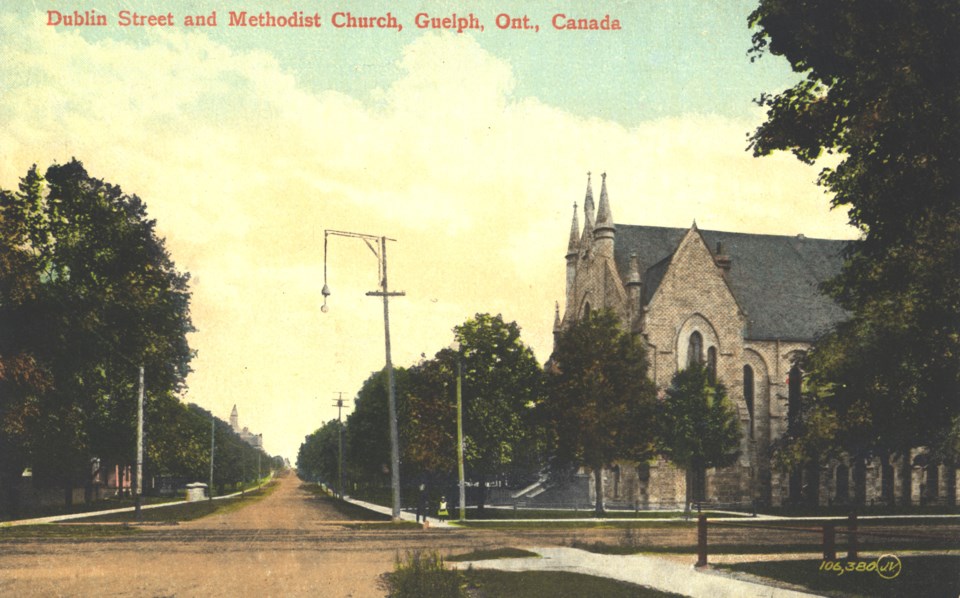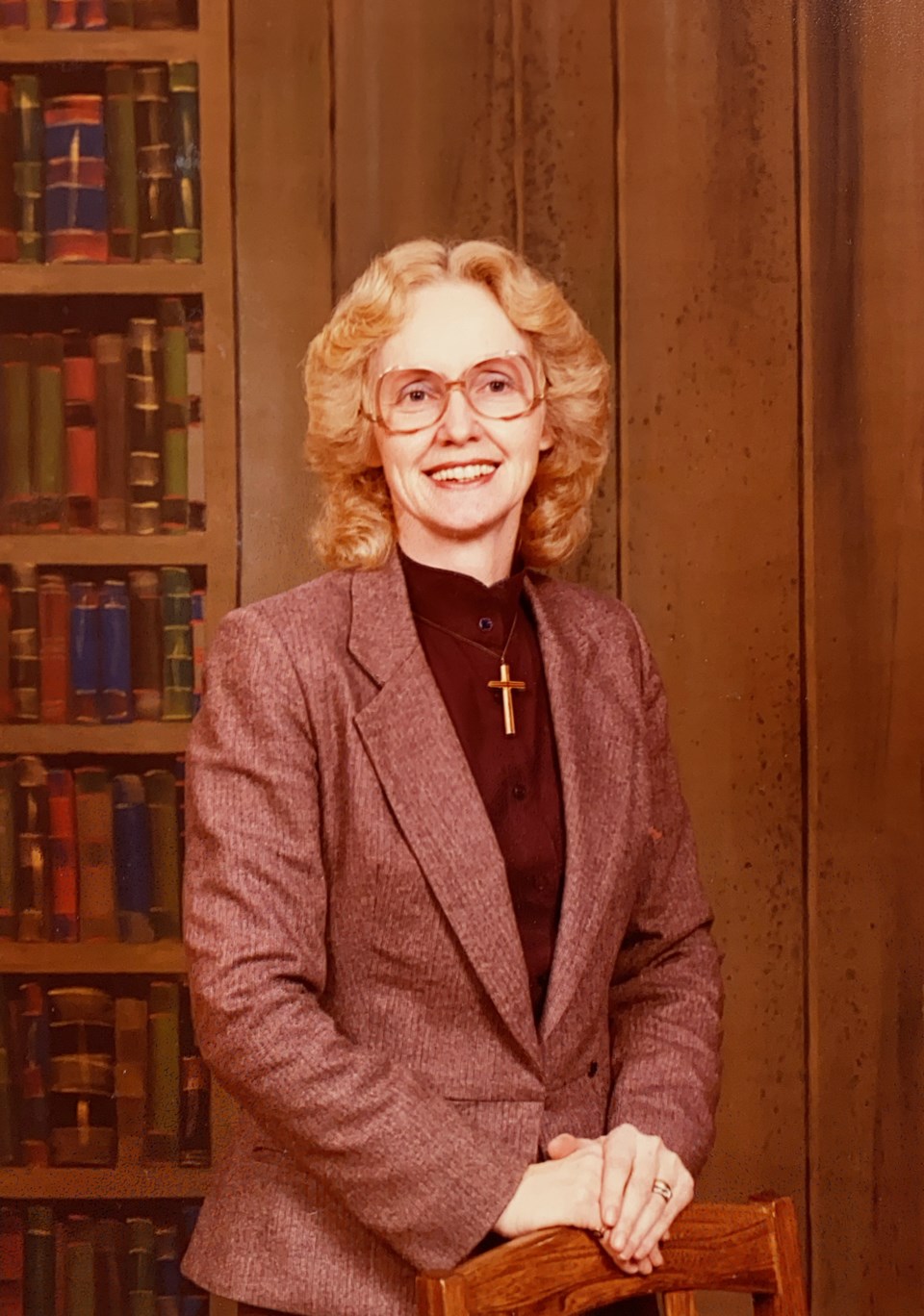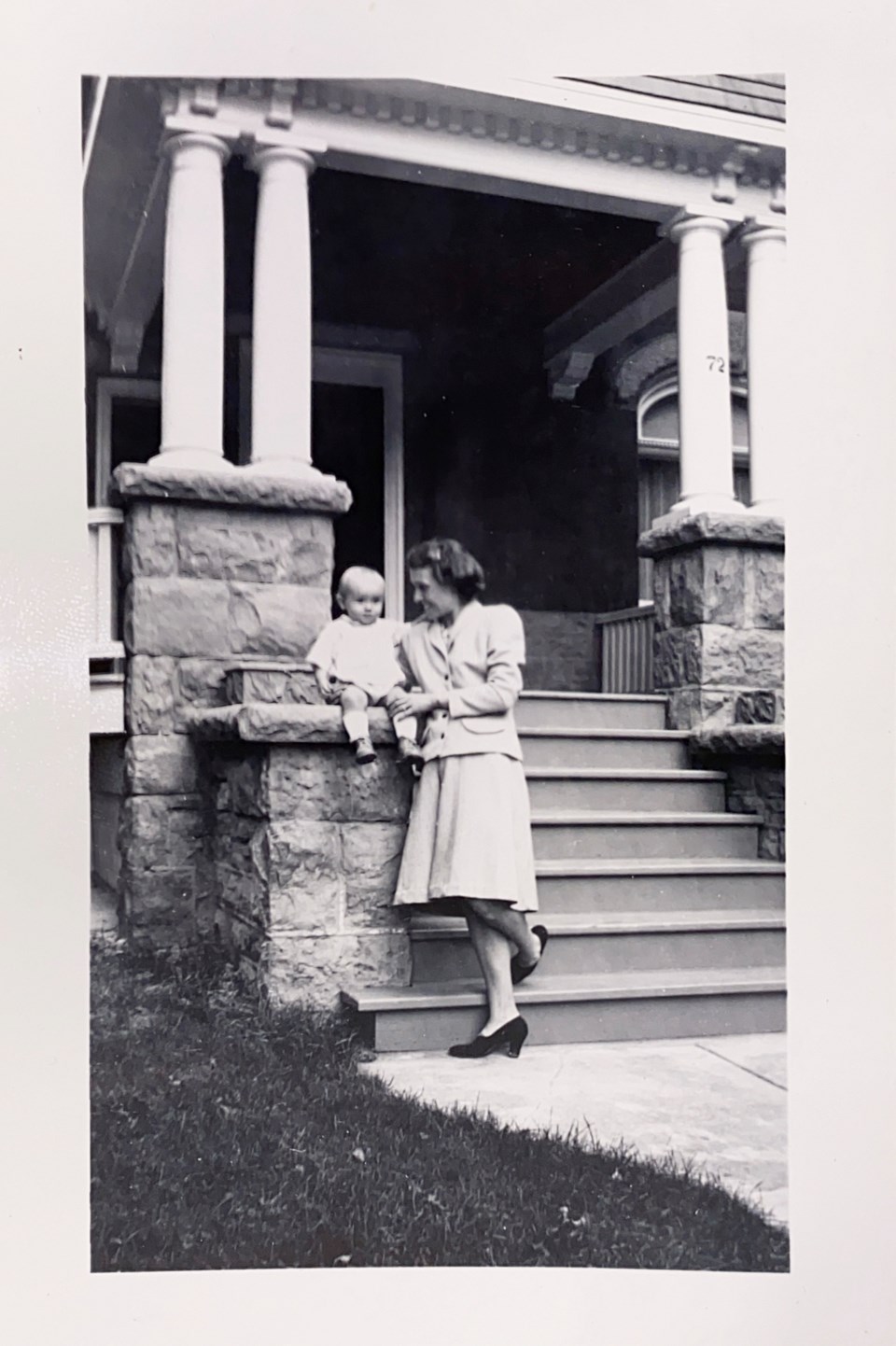It was almost 'McTague Street United Church.'
Dublin Street United Church, which is celebrating its 150th anniversary this year, has “the longest roots” as a United church in Guelph, said Rev. Bruce Dickson, who has been with Dublin Street for the last 11 years.
The church has a congregation of roughly 400.
It was originally supposed to be built on McTague Street but the final location was the corner of Suffolk Street and Dublin Street.

The area was then known as the suburbs of Guelph, said Dickson.
Toronto architectural firm Smith and Gemmell created a design for a modified Gothic style church, explained local historian Gilbert Stelter in A Historical Sketch of Dublin Street United Church, Guelph.
The church wanted white brick to be laid but it was too expensive, so lucky limestone was chosen, says church member Leanne Johns.
Guelph didn’t have clay to make bricks but it did have limestone, adds Susan Ratcliffe, site coordinator of Doors Open Guelph. In 1874 brick wasn’t a common building material and none of the early churches were made of brick, she said.
The church has the trowel used to lay down the first stone and it was used again when an addition was added 1956.
Dublin Street was created out of the Norfolk Wesleyan Methodist Church which eventually turned into Norfolk Street United Church. The downtown church was sold to Lakeside Church and Hope House, said Dickson.
In need of a new home shovels went into the ground in 1874. Two years later the first church services were held in the building.
The Methodist church, some Presbyterian churches and the United church came together in 1925.
“So 1925 was a pivotal time for most United churches joining together,” said Dickson.
“So in the United church creed, it actually says that all may be one. So that was their driving vision at the time. Is that they were hopeful that this would be just one coming together of churches at that time. And the hope was that others might come together."
The vision didn’t change until the 1970s and 80s where instead of coming together as one church the United church would work together with Anglicans, Catholics and Presbyterians, Dickson said.
The start of inclusiveness could be pinpointed to when United churches welcomed women ministers in 1936 with the first being Rev. Lydia Gruchy.
For Dublin Street, women in the congregation took a “more of an active role in the leadership,” said Dickson. It implemented a women’s group. The first woman minister at Dublin was Donna Mann. She served from 1984 to 1990.

“I think people were quite open to it,” said Anstice Blom, church trustee and longtime member. “I don't think I saw it as anything particularly out of the ordinary. It just seemed like she was a good person. It was the right fit."
The next step of inclusiveness was around communion and baptism where people were welcomed even if they were from different denominations, said Dickson.
In the 1960s there was inclusion of divorced people “and there was a time when ministers if they were divorced, were almost seen as they should stop being a minister. It had changed over time,” he said.
In the late 1980s membership within United churches opened up to people regardless of their sexual orientation.
In 2022 Dublin Street United Church became a certified affirming ministry.
While most United churches say they are welcoming to LGBTQIA+ people some churches “they have found that not every church that says we are welcoming is safe,” said Dickson.
The Affirming Ministries Program is a two-year period where United churches undergo education to understand its biases, the importance of pronouns, language use, showing sensitivity when asking questions, and more, said Dickson.
“The other part of being an affirming community is that you're striving then to also lift the rights and, and the place of other in their lives,” he said.
An example he gave was being a part of Pride in the Park.
It’s an affirmation to members of the congregation that they belong, he said.
In 1920 there was a flu epidemic and the church decided not to celebrate its anniversary because of it, said the book commemorating the 125th anniversary by church member Sheila McLaren.
In 2020 it was a welcomed shift to have service online since people could join who may have not been able to join before, Dickson said.
Johns said it was a blessing the service could move online because her mother was able to attend.
“The last picture I have before she died is her sitting in rehab, watching the church service and she died four days later,” said Johns.
Blom was “born in the parking lot” of the church she jokingly tells people. Her family home was on 72 Suffolk St. She lived there until she was four-years-old. It was sold to another family who lived there about eight years before it was sold to the church and torn down, she said.

The parking lot was expanded around the time the church put in an addition in 1956.
She grew up going to the church. Her parents Archie and Aleda Ledingham were involved in various groups and committees.
Blom was ready to go to church service one day but her family wasn’t. “So I just took myself next door more or less to the church,” she said. Her mother was looking for her and didn’t know she was already there.
Dublin was where Blom met her late husband Harmen. He invited her to join the youth group and the two hit it off. Blom was married at 17-years-old at the church. Both her daughters were baptized there. Funeral services for her parents and husband happened there too.
Harmen was part of the church choir almost right up until the time of his passing. He would help with repairs and maintenance of the building.
“I guess it's just a familiar part of my life. It's comforting,” Blom said.
Her favourite part of the church is the sanctuary since she has a sense of peace there. “I have come a couple of times when I've heard bad news and just gone up and sat in it for a while,” she said.
Could Dublin Street United Church last another 150 years?
“The building can. It’s limestone,” said Ratcliffe in response to the question.
Guelph will turn 200 soon and “a lot of those churches are approaching that anniversary, because they were important in that era in the 1870s. That was a social centre,” she said.
“I think it has to change to, to meet the needs of today's society. But I hope there will be a church there still or in 150 years, what will we be thinking? I don't know,” said Blom.
“Churches exist because God needs them to be there. And I think churches that are responsive to the needs of community around them stay open. And if God doesn't need that expression of that space in the same way anymore, they don't exist, they don't go forward,” said Dickson.
He sees the church moving forward because it impacts and cares for the community.
In tandem with the anniversary the church will be part of Doors Open Guelph in April. It was last featured in 2007 at Doors Open.
To commemorate Dublin Street church custodian and resident artist Robert Howson is going to create an art piece by making a print from a 150-year-old tree stump. He wanted to dig up information about the church so he could put each piece of history on the coordinating tree ring.
Johns finds the most interesting parts of the church’s history is it used to have outhouses and didn't have electricity or running water.
If a family had the means they could pay a pew tax so their name was on the pew to reserve it for church services. There was a vote to get rid of it and replace it with envelope collection, said Johns.
In 1928 the names were taken off the pews, she said.
The church faced financial worries in the late 1870s, as described in the book by McLaren.
A list of expenses for one year:
Wood purchased from Kloepfers: $80
Gas lighting: $31
Organ pumping: $15
Minister’s salary: $1,000
Organist: $300
Sexton (custodian): $120
Parsonage rental (where the minister lived): $150
Children’s Fund: $108
The church had $17,000 of debt and to reduce costs it was suggested to lower the minister and organist’s salaries. The church wouldn’t have a sexton anymore.
The mortgage was paid off in 1919 by a $2,300 donation from Joseph Tovell, said in an excerpt from Historic Guelph The Royal City called Dublin Street United Church (1874-1999) by Gilbert Stelter and Sheila McLaren.
Tovell was a harness marker and is known for the Tovell Block build which housed the Royal Bank in Downtown Guelph, said in records from the Guelph Civic Museum.
"The hard part is that at some point, this building this space may not serve what needs to happen in the city of Guelph from the United churches, what we're trying to do and if that's the case then we will celebrate its closure, and we will see what comes next," said Dickson.
He finds it difficult to think the space won't be needed.
